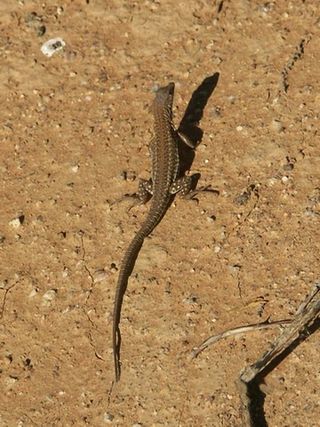
Nucras is a genus of African lacertid lizards, commonly called sandveld lizards.

Pedioplanis is a genus of lizards in the family Lacertidae. All species of Pedioplanis are endemic to southern Africa.

Chondrodactylus bibronii, commonly known as Bibron's thick-toed gecko, Bibron's sand gecko, or simply Bibron's gecko, is a species of lizard in the family Gekkonidae. The species is native to southern Africa. C. bibronii has been used as an animal model in bioastronautic research examining the effects of spaceflight on the morphology and physiology of vertebrates.
Richard Sternfeld was a German-Jewish herpetologist, who was responsible for describing over forty species of amphibians and reptiles, particularly from Germany's African and Pacific colonies.

Ichnotropis capensis is a species of African lizard, which is native to the southern Afrotropics. It is the type species for the genus Ichnotropis, and is commonly called the Cape rough-scaled lizard due to them being found in southern Africa's Cape region. They are also called ornate rough-scaled lizard or Smith's rough-scaled sand lizard. The small lizards are terrestrial and occur in grassland, desert and brush areas of southern Africa.
Latastia johnstonii, also known commonly as Johnston's long-tailed lizard, the Malawi long-tailed lizard, and the Nyasaland long-tailed lizard, is a species of lizard in the family Lacertidae. The species is native to East Africa.

The shovel-snouted lizard, also known commonly as Anchieta's desert lizard, Anchieta's dune lizard and the Namib sand-diver, is a species of lizard in the family Lacertidae. The species is native to southern Africa.

Meroles knoxii, also known commonly as Knox's desert lizard and Knox's ocellated sand lizard, is a species of sand-dwelling lizard in the family Lacertidae. The species is native to southern Africa.
Pedioplanis bengulensis, known commonly as the Angolan sand lizard or Bocage's sand lizard, is a species of lizard in the family Lacertidae. The species is endemic to Southern Africa.

Pedioplanis burchelli, known commonly as Burchell's sand lizard, is a species of lizard in the family Lacertidae. The species is native to Southern Africa.
Pedioplanis gaerdesi, known commonly as the Kaokoland sand lizard, the Kaokoveld sand lizard, and Mayer's sand lizard, is a species of lizard in the family Lacertidae. The species is endemic to Namibia.
Pedioplanis haackei is a species of lizard in the family Lacertidae. The species is endemic to Angola.
Pedioplanis huntleyi is a species of lizard in the family Lacertidae. The species is endemic to Angola.
Pedioplanis husabensis, also called Husab lizard, is a species of lizard in the family Lacertidae. The species is endemic to Namibia.
Pedioplanis inornata, known commonly as the plain sand lizard or the western sand lizard, is a species of lizard in the family Lacertidae. The species is endemic to Southern Africa.

Pedioplanis lineoocellata, known commonly as the common sand lizard, the ocellated sand lizard, and the spotted sand lizard, is a species of lizard in the family Lacertidae. The species is endemic to Southern Africa. There are three recognized subspecies.

Pedioplanis namaquensis, known commonly as the Namaqua sand lizard or l'Érémias namaquois, is a species of lizard in the family Lacertidae. The species is endemic to Southern Africa.
Pedioplanis rubens, called commonly the Waterberg sand lizard, reddish sand lizard, and (misleadingly) Ruben's sand lizard, is a species of lizard in the family Lacertidae. The species is endemic to Namibia.
Pedioplanis undata, known commonly as the plain sand lizard or the western sand lizard, is a species of lizard in the family Lacertidae. The species is endemic to Southern Africa.

Pedioplanis branchi is a species of lizard in the family Lacertidae. The species is endemic to Namibia. It is named after the British-born South African herpetologist William Roy Branch.









